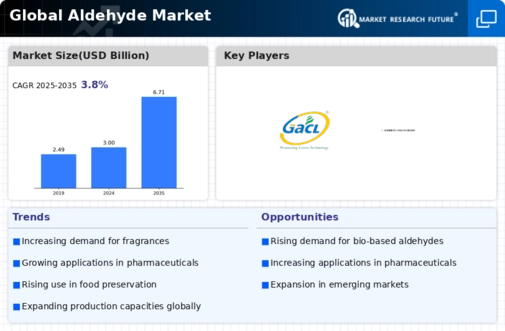Aldehyde Size
Aldehyde Market Growth Projections and Opportunities
The Aldehyde Market is influenced by a myriad of factors that collectively shape its dynamics, growth trends, and overall competitiveness. These factors span from industry-specific considerations to broader economic and environmental influences. Here's a succinct breakdown of key market factors defining the landscape of the Aldehyde Market:
Versatile Industrial Applications:
Aldehydes play a crucial role in various industrial applications, serving as key intermediates in the production of chemicals, plastics, and pharmaceuticals.
The versatility of aldehydes in multiple industries, including agriculture, healthcare, and manufacturing, significantly influences market demand.
Formaldehyde Dominance:
Formaldehyde, a prominent member of the aldehyde family, holds a dominant position in the market and is extensively used in the production of resins, adhesives, and textiles.
The demand for formaldehyde-based products in construction, wood panels, and automotive applications contributes substantially to the overall aldehyde market.
Preservative and Disinfectant Applications:
Certain aldehydes, such as glutaraldehyde and benzaldehyde, find applications as preservatives and disinfectants in healthcare, water treatment, and cosmetic formulations.
The healthcare industry's reliance on aldehydes for sterilization and preservation purposes influences market dynamics.
Flavors and Fragrances Industry Demand:
Aldehydes are essential components in the flavors and fragrances industry, contributing distinctive notes to perfumes, cosmetics, and food products.
The demand for unique and appealing scents in consumer goods drives the market for aldehydes in the flavors and fragrances sector.
Pharmaceutical Intermediates Production:
Aldehydes serve as important intermediates in the synthesis of pharmaceutical compounds, contributing to the production of medicines and pharmaceutical ingredients.
The pharmaceutical industry's demand for specific aldehydes influences market growth.
Agrochemical Applications:
Aldehydes play a role in the formulation of agrochemicals, contributing to the development of pesticides, herbicides, and fungicides.
The agriculture sector's need for effective crop protection solutions impacts the demand for aldehydes in agrochemical applications.
Shift towards Bio-Based Aldehydes:
Growing environmental awareness and sustainability considerations drive the development and adoption of bio-based aldehydes derived from renewable resources.
Manufacturers exploring eco-friendly alternatives respond to changing consumer preferences and regulatory trends.
Regulatory Compliance and Safety Standards:
Stringent regulatory standards and safety considerations impact the production and use of aldehydes.
Compliance with regulations regarding the handling, transportation, and disposal of aldehydes is crucial for market players to ensure safety and regulatory adherence.
Technological Advancements in Production Processes:
Ongoing technological advancements in chemical synthesis contribute to the development of more efficient and sustainable methods for aldehyde production.
Innovations in production technologies play a role in enhancing the competitiveness of aldehydes in the market.
Global Economic Conditions:
Economic factors, including GDP growth, industrial output, and consumer spending, impact the overall demand for aldehydes in various end-use sectors.
Economic trends influence investment decisions and consumption patterns in key markets, shaping the trajectory of the aldehyde market.
Price Volatility of Raw Materials:
The aldehyde market is sensitive to fluctuations in the prices of raw materials, such as methanol and acetylene, impacting production costs.
Price volatility poses challenges for manufacturers in maintaining stable pricing strategies and profit margins.
Competitive Landscape and Market Consolidation:
The aldehyde market witnesses competitive dynamics with key players engaging in mergers, acquisitions, and strategic alliances.
Market consolidation efforts contribute to the emergence of dominant players with a diverse product portfolio and global market presence.






Leave a Comment